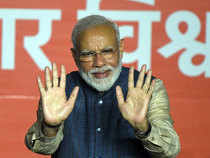NEW DELHI: With the major event risk of election out of the way, analysts on Dalal Street have started speculating on what measures the government may unveil in its first 100 days of the second term.
With the economy slowing, demand situation sluggish, farm sector in distress and a part of the financial markets wrestling with a crippling liquidity squeeze, the government has to hit the ground running.
On Friday, it was made official that the government will start second innings on May 30. Finance and other ministries are said to have already lined up measures for the new government to consider to pump-prime the economy.
In its poll manifesto, BJP promised to turn India into a $5 trillion economy by 2025 and reiterated its promise to double farm income by 2022. To deal with the slowing economy, the government may first look at the low-hanging fruits in the first 100 days, analysts said.
Some economists say the government may use the full Budget, due early July, to address the demand side issues, which may include a cut in individual income tax to boost consumption.
This along with another 25 basis points rate cut expected from RBI on June 6 could help reverse the demand slowdown.
Measures like further simplification of the GST structure and incentives for MSMEs to generate employment could also come in, IIFL Institutional Equities said in a note.
GST tax slabs could be merged into two main rates from four at present.
Analysts noted that the BJP election manifesto talked about simplification of the GST process and lowering time spent for tax compliance to 1 hour per month. It also promises reduced tax rates, higher tax collection and better compliance.
“If one reads the manifesto with the forthcoming changes to the GST compliance process, i.e. new return forms and e-invoicing facility, and interim Budget speech, the focus may be on better tax compliance through automation and ease of doing business,” said Jigar Doshi, Executive Director at SKP Business Consulting.
The government may open channels for more dialogue with industry stakeholders on simplification of the GST structure, Doshi said.
BofA-ML said a renewed popular mandate for the Modi government should make it easier for the Jalan Committee to hand over the excess RBI capital in one shot to the Ministry of Finance. The brokerage expects the finance ministry to recapitalise PSU banks with this excess RBI capital. The Jalan Committee report is due by June.
UBS expects broad-spectrum policy support, including fiscal incentives, subject to being WTO compliant.
It cited Commerce and Industry Minister Suresh Prabhu’s recent comment in which he said the government was working on a new industrial policy that will link the country with the global supply chain.
“The code on wages was introduced in Lok Sabha in 2017, and the Parliamentary Standing Committee has already reviewed and given its recommendations on it in December 2018. It is likely that this would be introduced in the Lower House shortly," said Credit Suisse.
Besides, eyes would also be on the labour code, which has already been presented to the Cabinet, but is awaiting clearance.
While these changes are mostly going to be replacements of existing laws, the simplified structure would be a significant step forward, making it harder for inspectors to harass businesses owners, Credit Suisse said.
Motilal Oswal Securities said from a near-term perspective, the immediate focus of the government would be to revive rural consumption, address liquidity stress of NBFCs and debt market in coordination with RBI, and drive spending to revive industrial growth.
The brokerage noted that real interest rates in the economy remain high, even as inflation is largely under control and within the target band of RBI. “Toward that effect, the next RBI policy in June and the first Budget of the new administration in July will be key policy events to watch out for,” it said.
“We believe the need to kick-start the economy is paramount, there should be fiscal and monetary stimuli, i.e. reflation over reforms,” said Edelweiss Securities.
Nomura India said the focus now shifts to the composition of the Cabinet, which is likely to be announced over the weekend and the Budget due early July.
“We believe unlike BJP’s first term, where prudence came at the cost of growth, the policy priority in the second term will be to reignite growth with prudence as a secondary priority. We expect a mix of rural reflationary policies, infrastructure spending, tax simplification and social investment (housingNSE 1.48 % for all),” the brokerage said.
Published On : 24-05-2019
Source : Economic Times

